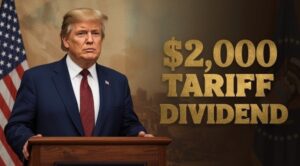Trump Unveils $2,000 Tariff Dividend: What It Means for Crypto
President Donald Trump announced on Sunday a plan to distribute a “dividend of at least $2,000” to most Americans, funded by tariff revenues. The proposal excludes high-income earners and aims to leverage the billions collected from import duties. The announcement triggered an immediate rally in cryptocurrency markets, with Bitcoin climbing 1.75% to $103,000, Ethereum rising 3.32% to $3,487, and Solana gaining 1.85% to $160.
This development has sparked intense debate about potential market implications. Crypto traders remember similar stimulus periods vividly. The proposed payment structure mirrors previous economic relief programs that significantly boosted digital asset prices.
Understanding Trump’s Tariff Dividend Plan
Treasury Secretary Scott Bessent clarified that the dividend could take several forms, including tax cuts—such as eliminating taxes on tips, overtime, and Social Security—and allowing deductions for auto loans. Administration officials emphasized these were brainstorming ideas rather than formal Congressional proposals.
According to estimates, over 85% of American adults would qualify for the dividend, potentially distributing more than $400 billion. If the high-income cutoff is set at $100,000, roughly 150 million adults would qualify, bringing the total cost to around $300 billion.
The proposal faces significant hurdles. In the summer of 2025, Senator Josh Hawley introduced legislation to provide Americans with $600 tariff rebates in the form of checks; however, the Senate has not yet voted on the bill. Congressional approval remains uncertain, with several Republican senators expressing opposition.
How the Tariff Dividend Could Impact Crypto Markets
The CoinDesk 20 index recovered from a nearly 15% weekly drawdown, rising more than 1.5% following Trump’s announcement. Traders appear to be pricing in potential increases in consumer spending and inflows into the crypto market.
Market analyst Jasper De Maere noted that in 2020, crypto’s institutional infrastructure was barely developed, with retail-led rallies fueled by stimulus checks and ultra-high-net-worth cash allowing rapid cascades from major coins to altcoins.
The current environment differs substantially from previous stimulus periods. Interest rates now hover above 4%, compared to near-zero rates in 2020 that galvanized yield-seeking across financial markets. The vastly larger crypto market capitalization also makes indiscriminate rallies less likely.
The proposal revived risk-on reflexes reminiscent of pandemic-era stimulus effects, even as questions persist about feasibility and potential inflationary impact. Overall crypto market capitalization climbed to approximately $3.5 trillion, with unusually high Sunday trading volumes reaching $113 billion.
Challenges Facing Tariff Dividend Implementation
A critical concern involves funding adequacy, as every dollar of tariff revenue offsets approximately 24 cents of income and payroll tax revenue. This creates a significant gap between proposed distributions and available funds.
The Supreme Court began hearing Trump’s tariff case in early November, examining whether the president has authority under the International Emergency Economic Powers Act to impose tariffs. Several justices expressed skepticism during oral arguments and worried about potential Congressional power usurpation.
Legal uncertainty adds volatility to market expectations. Prediction markets reflect widespread doubt about Supreme Court approval. If the court rules against Trump, the government might need to refund billions already collected, eliminating the funding source for any dividend payments.
Crypto Market Outlook Amid Tariff Dividend Buzz
XRP delivered market-beating performance following the tariff dividend announcement, coinciding with Canary Capital’s filing of its third pre-effective amendment for the proposed Canary XRP ETF. The trust would hold XRP in custody with Gemini and BitGo, benchmarked to specific pricing indices.
Any upcoming altseason will likely be more selective and disciplined, driven by genuine utility rather than speculative hype, demanding rigorous analysis to distinguish real-world applications from empty promises.
Whether the tariff dividend becomes law or remains a campaign talking point, traders appear willing to front-run the liquidity narrative again. The combination of potential fiscal stimulus and Federal Reserve interest rate adjustments creates conditions that historically favored risk asset appreciation.
Conclusion
Trump’s tariff dividend proposal represents a significant policy announcement, though Treasury Secretary Bessent acknowledged he had not discussed the specific plan with the president. The crypto market’s positive response reflects optimism about potential liquidity injections, despite considerable implementation obstacles. Congressional approval requirements, Supreme Court challenges, and funding gaps present substantial barriers. Investors should monitor regulatory developments and on-chain metrics carefully as this situation evolves.

